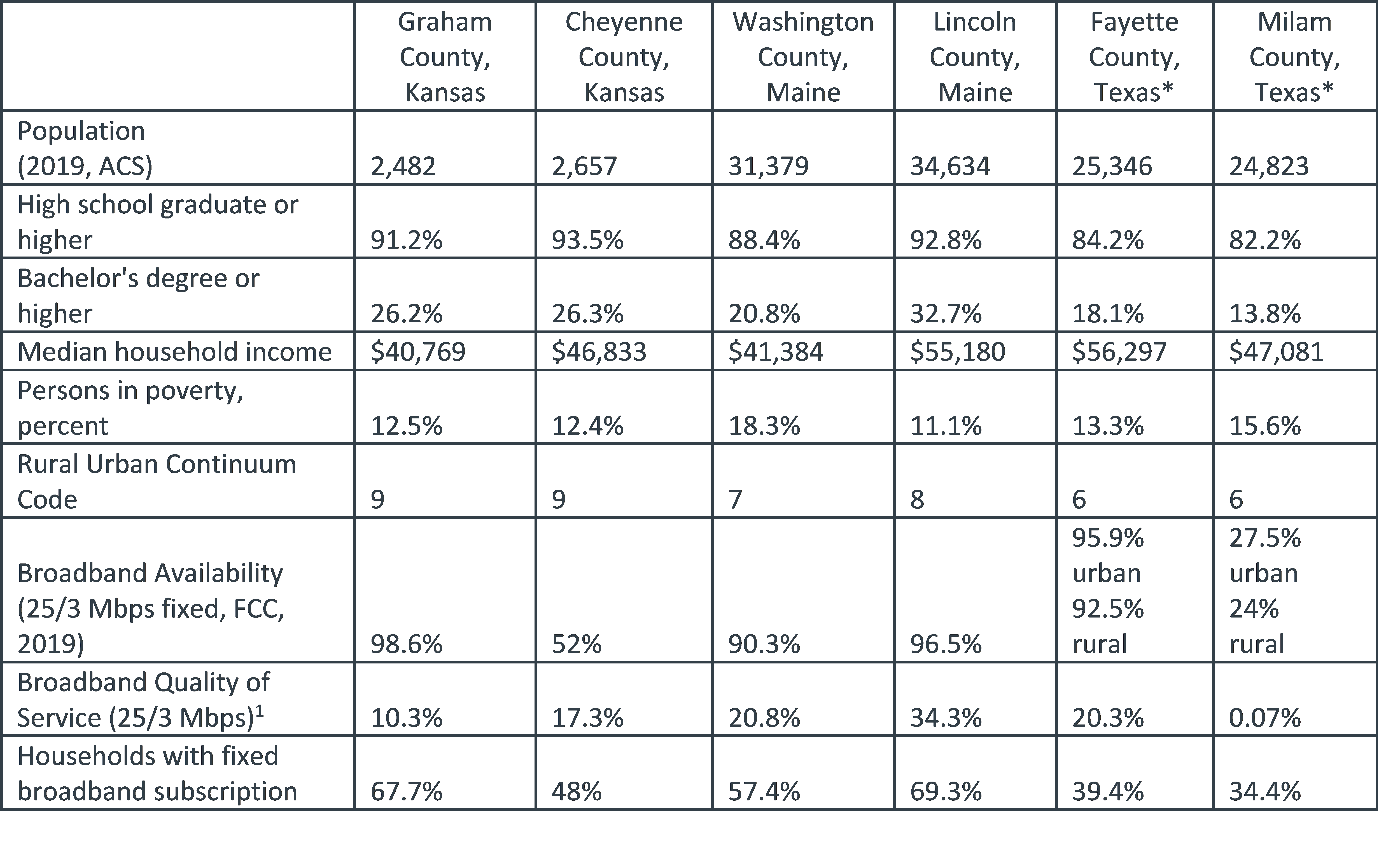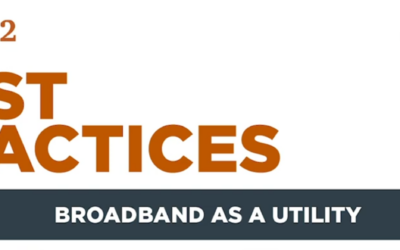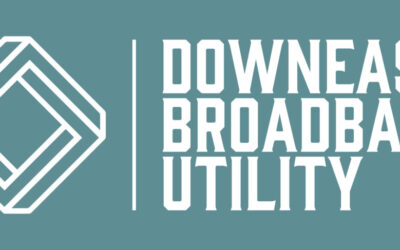Broadband and Entrepreneurship in Small and Rural Communities
Business Growth and Broadband
A team of researchers at TIPI is exploring the intricate relationships between information technology infrastructure and business growth in a project sponsored by the IC2 Institute at the University of Texas at Austin. The project, “Broadband and the Rural Entrepreneurial Ecosystem”, focuses on small and rural counties in Texas, Kansas, and Maine.
Avoiding a “rural deficit” framework, this research has the goal of understanding how incremental improvements in the capacity and cost of local rural broadband connectivity can make a difference for local entrepreneurship systems. The project hopes to contribute quantitative data to participating communities relating broadband and business statistics. The project seeks the input of local stakeholders to help understand the present and future technology and Internet needs of small and rural communities
There is a need to understand the relationship between broadband and the resiliency of rural areas in the United States. Broadband is a critical component of today’s economy, and rural communities still face disparities in broadband availability, price, and speed. About 65% of rural Americans have access to high-speed fixed service compared to 97% of urban dwellers, not counting mobile phone access. Some sources argue that these figures inflate the lived-realities of rural citizens.
The Internet is increasingly embedded in all aspects of life in the U.S., and Internet access and the skills to use, maintain, and build Internet systems are essential. Businesses rely on the Internet in order to do everything from accessing supplies, engaging with customers, and securing capital. Broadband has an important role in retaining human capital, but often is a foundational service that rural areas have in short supply.
Guiding Questions
Our research goal is to characterize and quantify the relationship between adequate broadband services and rural entrepreneurial endeavors, and to assess which policies – whether governmental, private, trade association-based or philanthropically supported – might improve the local entrepreneurship ecosystem. We formulated the following research questions to guide our work:
-
- What is the role of local broadband in entrepreneurial activities in rural regions?
- How can broadband improvements support or improve entrepreneurship in rural areas?
- What policies – public and private – might enhance broadband’s availability and our understanding of how entrepreneurs use it?
Our Approach
The study has two phases:
Phase 1 examines county-level data in the three target states of TX, KS, and ME in order to analyze how different qualities and reach of broadband in nonmetro regions are related statistically to indicators of entrepreneurship.
Phase 2 incorporates a matched-county qualitative investigation (six counties in three states) in order to assess differences between counties with faster, more reliable and diffuse broadband compared to counties with constrained access to broadband. We chose the three states because we have worked there before and have a small network of contacts, because we understand their governance systems both locally and at the state level, and because they offer three different sets of broadband and policy environments.
Phase 1
In Phase 1 we assembled a database of statistics measuring economic activity and entrepreneurial activity from various sources including the US Census, the American Community Survey (ACS), and the Bureau of Economic Analysis (BEA). Specifically, we use the percentage of non-farm proprietors over total employment as a representation of entrepreneurship of a count. This indicatory has been used widely in previous studies (e.g., Conley & Whitacre, 2016; Conroy, Deller & Kures, 2019). In addition, we explore “venture density” data from GoDaddy as another new measure of entrepreneurial activities (Mossberger, Tolbert, & LaCombe, 2020). Venture density reports on the presence of online webhosting activity at the county level. Hence, it is an indirect indicator of a certain type of economic activity and captures small-to-medium size industries.
We compiled a database of statistics that measure broadband in the United States, including the federally-compiled Form 477 data from the Federal Communications Commission (FCC) that records broadband availability in the US. We supplement these statistics with broadband adoption data from the Census-produced American Community Survey that measures whether or not a household has a fixed broadband subscription (among other metrics). We also explore connectivity data from Microsoft and M-lab; their data indicate the quality of broadband connections and thus hint at broadband reliability and speeds, both factors that come up in examining the contribution of broadband to economic activity.
Phase 2
The research sites chosen for Phase 2 of this project build on earlier research in Texas, Kansas, and Maine, leveraging our familiarity with some aspects of the broadband landscape, the leadership environment and the issues afoot in the rural regions of the three states. As well, the states differ in many important ways, including their size and geographies, their main industries, and their policy approaches to broadband. We are conducting interviews with key individuals in business leadership, economic development, and public affairs. We interview businesses, economic development personnel, telecommunications providers and community leaders to better understand how broadband capabilities figure into entrepreneurial strategies, plans, operations and capabilities in our counties. While our analytic focus is on matched counties in each state, our work also considers the role of state policies or environments as well as specific developments in our target counties.
The counties we focus on in this project are: Graham County and Cheyenne County, Kansas; Washington County and Lincoln County, Maine; Milam County and Fayette County, Texas. As outlined in Table 1 below, the demographics, rurality, and general economic landscapes of counties chosen in each state are comparable to their partner county. The major difference in these counties is the availability, reliability, or speed/quality of broadband service.
Table 1: Selected Counties by Indicators

* 2019 FCC Broadband Deployment Report
[1] Broadband quality of service measure is calculated using broadband data from Microsoft and M-lab. Using different methods, Microsoft and M-lab data shows the extent to which broadband service was actually delivered at 25/3Mbps speed quality. Microsoft utilizes speed logged during its software updates on various computer devices, while M-lab utilizes voluntary broadband speed tests. Statistics here are a composite average of the two.
Results
Analyses in both cross-sectional designs investigate the statistical links between various broadband indicators and local entrepreneurial activity. We have conducted interviews in our six counties to gather data from business owners and local economic development staff. We have been sharing our results with various experts in the field, in part to obtain their insights regarding the findings and to solicit new ideas about additional datasets that may be useful.
-
- Regression results from Phase 1 offer evidence that poor or skewed broadband measurements from the FCC overestimate connectivity when FCC measures are compared to those of Microsoft and MLab. The different data sources portray different broadband realities in rural areas. Although the FCC’s broadband availability data indicate that the majority of populations in Texas, Maine, and Kansas have broadband service, far fewer people actually experience broadband service with sufficient quality of service. Furthermore, preliminary correlation analyses between the broadband availability and broadband quality of service indicates that the gap between availability and quality of service is greater for rural areas.
- Second, initial analyses of relationships between broadband and entrepreneurship show that having higher speed broadband available has greater impact on the share of non-farm proprietorship in rural areas than urban areas. In terms of venture density, broadband availability and quality of service showed positive impact. However, we witnessed counterintuitive results when broadband’s influence on venture density was examined across rural and urban areas. Results suggest that the nature and size of the entrepreneurial venture specifies the significance of broadband locally. We intend to advance and fine tune the models over the next few months.
- Interviews with local businesses and economic development leaders suggest patterns in how community leaders link broadband to economic stability and future growth in their cities and towns. Our 26 interviews to date provide deep contextual background on the communication landscape of the community. We document day-to-day constraints due to broadband underservice to various businesses. That is, broadband may be present, but its unreliability and poor speed jeopardize stable business operations.
- Individual business owners wield outsized importance in helping shift the focus of their respective communities towards broadband. Entrepreneurs share with us they seek action towards broadband planning due to the fact that they are business owners; they share with us that they need robust broadband to sustain and grow their operations.
- New media and social networks are integral for small businesses to compete with larger retailers. Entrepreneurs describe creative ways they use Facebook, Instagram, email listservs, and other platforms to do business with their neighbors and reach beyond their location. Also, cloud computing services help small businesses streamline their business activity from on premise sales to e-commerce. Cloud technology collapses the need for multiple interfaces, but there needs to be a robust and reliable enough signal for businesses.
- New commercial arrangements were created by the pandemic. Beyond seeking new supply arrangements, Facebook is an important tool for producers; impromptu groups have organized to help farmers, fishers, and others in pivoting their sales to direct-to-consumers. These groups help sustain hyperlocal trade in the pandemic and fill the vacuum COVID has caused by shuttering restaurants and reducing opportunity to sell to distributors.
- The depth and breadth of technology use by entrepreneurs in the project provide strong evidence that business owners in small and rural locations are using innovative technologies creatively; however, business owners report that they need significantly more and reliable bandwidth to remain competitive.
- Small communities with robust broadband often benefit from local or cooperatively owned telecom infrastructure companies. Communities with constrained broadband, on the other hand, seek to bring broadband to their location when large, incumbent providers fail to serve their needs. We learned of instances when two or three individual business owners or local institutions rallied their neighbors to advocate for better broadband, the direct result in a couple of cases being the formation of a local broadband committee. In three examples, we heard that committees approached cable incumbents with proposals to fund new infrastructure but were turned down by these large incumbents. In two communities, small and local telephone companies rose to the need, and in the third, the community created a local broadband utility owned by the citizens. Importantly, these communities express eagerness to share the process of alternative broadband arrangements to help change the tide of underservice in other communities like theirs.
Research Team
Sharon Strover
Alexis Schrubbe
Jaewon Choi
Latest Project News
Broadband as a Utility – Roundtable Discussion
TIPI's Dr. Sharon Strover recently joined Professor Sherri Greenberg and Dr. Kenneth Flamm for a conversation on broadband as a utility in Texas with Dr. Art Markman...
Two Dogs and a Blog: Boothbay Pet Outfitters Bits, Bytes, and Barks
Two Salty Dogs Pet Outfitters may be tucked away in a corner of Maine’s Boothbay Harbor, but the 500 sq. ft shop occupies a much larger footprint in cyberspace by...
Downeast Broadband Utility: Citizen-Powered Fiber Optic Internet Comes to Rural Maine
During a recent visit to Calais, Maine, our team heard from residents that fiber Internet would soon be coming to every house and business in the town.
Redundancy is the Key to Stability – The Bling Box Boutique in Cameron, TX
The Bling Box Boutique began as an experiment by Jeremy and Courtney Renaud eleven years ago. In a recent interview with the TIPI research team, Jeremy explained that...
Broadband: “The Backbone of Communication”
The term 'broadband' refers to an advanced telecommunication service that developed from a need for greater amounts of information to be transmitted across the...
Contact us
Find Us
2504 Whitis Ave.
CMA 5.102
Austin, TX 78712
Phone
512-471-5826
Social
Twitter: @texastipi
Facebook: @texastipi





